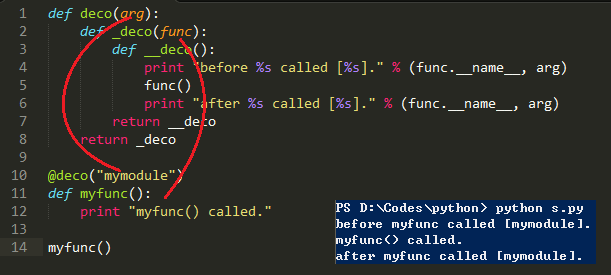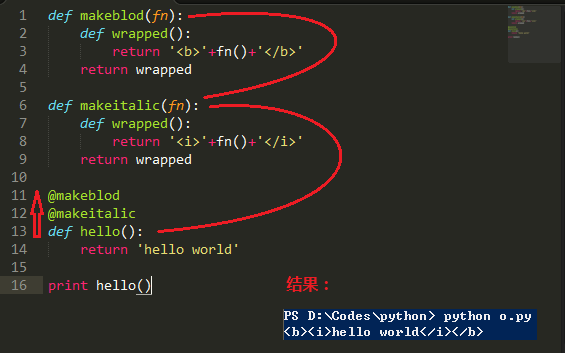装饰器模式定义:动态地给一个对象添加一些额外的职责。
在 Python 中 Decorator Mode 可以按照像其它编程语言如 C++、Java 等的样子来实现,但是 Python 在应用装饰概念方面的能力上远不止于此, Python 提供了一个语法和一个编程特性来加强这方面的功能。
首先需要了解一下 Python 中闭包的概念:如果在一个内部函数里,对在外部作用域(但不是在全局作用域)的变量进行引用,那么内部函数就被认为是闭包(closure)。

1
2
3
4
5
6
7
8
9
10
11
12
13
14
15
16
| def makeblod(fn):
def wrapped():
return '<b>'+fn()+'</b>'
return wrapped
def makeitalic(fn):
def wrapped():
return '<i>'+fn()+'</i>'
return wrapped
@makeblod
@makeitalic
def hello():
return 'hello world'
print hello()
|

1
2
3
4
5
6
7
8
9
10
11
12
13
| def deco(arg):
def _deco(func):
def __deco():
print "before %s called [%s]." % (func.__name__, arg)
func()
print "after %s called [%s]." % (func.__name__, arg)
return __deco
return _deco
@deco("mymodule")
def myfunc():
print "myfunc() called."
myfunc()
|
闭包学习:
http://blog.csdn.net/marty_fu/article/details/7679297
接收参数的装饰器
1
2
3
4
5
6
7
8
9
10
11
12
13
14
15
16
17
18
19
| import time
def decorator(run_count):
def _decorator(fun):
def wrapper(*args, **kwargs):
start = time.time()
for i in xrange(run_count):
fun(*args, **kwargs)
runtime = time.time() - start
print runtime
return wrapper
return _decorator
@decorator(2)
def do_something(name):
time.sleep(0.1)
print "play game " + name
do_something("san guo sha")
|
装饰器类
1
2
3
4
5
6
7
8
9
10
11
12
13
14
15
16
17
18
19
20
21
22
23
| import time
class decorator(object):
def __init__(self, count):
self._count = count
def __call__(self, fun):
self.fun = fun
return self.call_fun
def call_fun(self, *args, **kwargs):
start = time.time()
for _ in range(self._count):
self.fun(*args, **kwargs)
runtime = time.time() - start
print runtime
@decorator(2)
def do_something():
time.sleep(0.1)
print "play game"
do_something()
|



